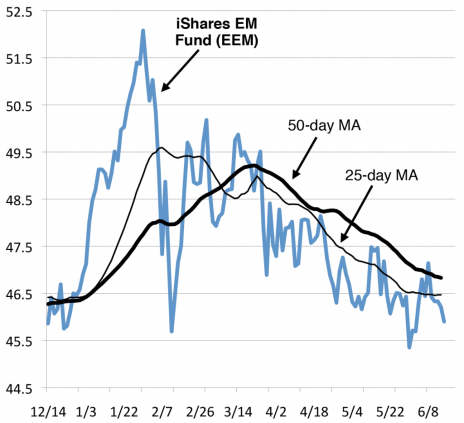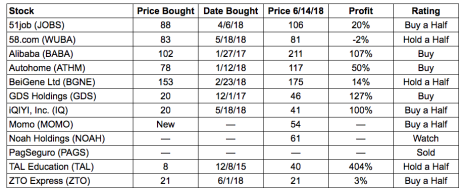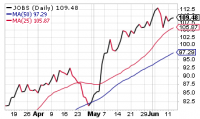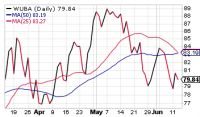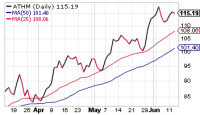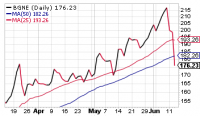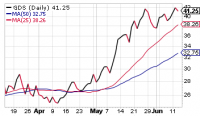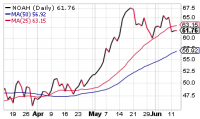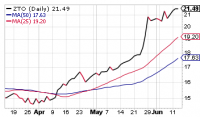The market continues its good news/bad news behavior, with emerging market stocks as a whole not doing well but Chinese stocks performing strongly. So, while we don’t have a formal Buy signal, we’re taking advantage of Chinese strength to inch a little deeper into the market. Today’s featured stock is another old friend that we’ve made money on before that has broken out of a nice consolidation pattern.
Cabot Emerging Markets Investor 661
[premium_html_toc post_id="151768"]
Cabot Emerging Markets Timer
The Emerging Markets Timer is our disciplined method for staying on the right side of the emerging markets. The Timer is bullish when the index is above the lower of its two moving averages and that moving average is trending up.
Our Emerging Markets Timer remains negative, as rallies have been unable to stick in recent weeks. You can see on the chart that the iShares EM Fund (EEM) has been trying to find support in the 45.5 to 46.5 area during the past few weeks, but every bounce toward the declining 50-day line brings in more sellers. Thus, the trend in the broad EM space is still down.
U.S.-traded Chinese stocks, represented by the Golden Dragon Fund (PGJ), remain in much better shape, actually poking up near their 2018 highs. Overall, we’re still taking things on a stock-by-stock basis, but holding some cash and being choosy on the buy side.
Talking About Investing
On Tuesday night, I spoke to the Boston Investors Group about “Investment Opportunities in Emerging Markets.” It was a lovely New England summer day and there was a pretty good turnout for an evening meeting on the MIT campus.
I talked at length about Cabot’s approach to growth investing, from market timing to stock screening and selection to portfolio construction, buying and selling. And I showed a bunch of charts of very strong emerging market stocks, including several that are in the portfolio now.
There were lots of questions, especially about China, which is a great mystery to most U.S. investors.
I came away from the encounter with a hoarse voice, a sense of real engagement and a couple of observations.
First, I realized (again) how much I enjoy the company of people who are curious enough (and courageous enough) to do their own stock investing. While a vast majority of investors are content to just shovel money into index funds and let time do the work for them, growth investors refuse to be passive. And it’s not easy to hit the BUY button on your online broker’s site when a large portion of the financial industry is telling you that you can’t survive as an individual investor.
Second, I realized how valuable it is for growth investors to talk to one another. While some people enjoy sitting in a quiet room, doing stock research and making decisions in splendid isolation, it can also be a lonely business. And talking to other investors can be really useful.
For instance, every time I talk to individual investors, I hear from someone who has just realized that selling growth stocks is much harder than buying them. Buying is fun and exciting. Selling is always the end of a story, no matter whether you’re booking a fat profit or just trying to cut a loss short after holding on longer than you should have.
Growth investors, especially those who keep at it over the years, have to have certain reserves of character and self-confidence. And that kind of personality doesn’t take easily to selling at a loss (which feels like admitting defeat) or letting a stock go because its chart isn’t going anywhere (which amounts to giving up hope).
In fact, learning how to sell is every bit as necessary to growth investing as knowing how to buy. But you might not know that if you hadn’t talked to other investors and found out that what you thought was your reluctance to sell was actually everybody’s reluctance to sell.
All this is really kind of a preamble to a special invitation to all of you, my subscribers, to come to the Cabot Wealth Summit in August in Salem, Massachusetts. From the cocktail party on August 15 to the presentation of analysts’ top picks for the year on August 17, the Summit will put you in direct touch with decades of investing experience. You can just sit back and absorb the practical presentations or ask questions to your heart’s content. And you can share your investing triumphs and challenges with other attendees whose experiences may match your own.
The Cabot Wealth Summit isn’t therapy, but you’ll be amazed how it can make you feel better about investing. (And personally, I think the Premium Bourbon Investing Seminar on Thursday night—with me presiding—is worth the entire trip.)
Featured Stock
Tinderbox?
Momo (MOMO)
On the one hand, Momo is just a mobile-based social networking platform that lets users stream live video to Apple, Android or Windows phones. The company makes money by charging for the live video service and gets a little extra from the sale of emojis and stickers, marketing to users and other value-added services. It’s technologically sophisticated, but can’t come close to reaching the audience of Weibo.
On the other hand, Momo is a fast-growing phenomenon with 103 million monthly active users (MAU), which is up from 85 million a year ago. The company’s software has a location-sensitive feature that can let users know when another user in close by, a feature that enabled meet-ups and earned the service the nickname “the Tinder of China.”
The company is also enjoying great revenue growth, up 64% in Q1 2018 after a gain of 57% in Q4 2017 and a string of triple-digit revenue gains in 12 of the previous 13 quarters. And the after-tax profit margin in the latest report was 32.7%.
Earnings grew by 57% in Q1 after a relatively subdued 20% increase in Q4. And management has issued guidance for Q2 calling for revenue of $470 million to $485 million, which represents growth of 51% to 55%.
Another intriguing aspect to the Momo story is the company’s acquisition of Tantan, an online social and dating app that probably deserves the “Tinder of China” label much more than Momo does. Momo acquired 100% of Tantan’s stock for 5.3 million newly issued Class A MOMO shares and $601 million in cash. Tantan’s strong position with young Chinese singles looking for love and relationships should provide a solid adjunct to existing business.
I have featured Momo twice before in Cabot Emerging Markets Investor, once in September 2016 and again in March 2017, each time recommending buying a half position. The 2016 buy ended in a loss of a point, while the 2017 buy went better, up from 23.6 to 38. But there’s no doubt that this is a volatile stock. A look at the chart shows a dead flat patch in April 2016 when it looked like the company would be bought up by Alibaba and the stock traded at the presumed takeover price. (And it would have disappeared if the Chinese government hadn’t objected.)
MOMO enjoyed a strong run in 2017 until it formed a double top at 46 in May and July, then gapped down in August and again in November, each time after earnings reports that appeared to beat expectations. The rebound after the November dip to 22.5 was immediate and forceful, pushing MOMO to 40 in March. The stock then formed a nice cup-shaped correction that bottomed at support at 34 in April and put in a right side and handle in May heading into earnings.
MOMO blasted off on enormous volume on May 29, jumping from 39 to 45 in a day and continuing to gain altitude right through today. MOMO is now trading at 53, which would seem extended if it weren’t for the 10-week cup-shaped correction from March through May. That correction has kept the stock’s P/E at a reasonable 26. And given the rapid increase in the number of institutional sponsors (up from 183 a year ago to 407 today), there should be plenty of buying appetite left for MOMO.
Given the stock’s volatility and the relative weakness in EM stocks as a group, we will once again start MOMO with a recommendation to buy a half position, but look to average up when we get a reasonable profit cushion. BUY A HALF.
Momo Inc. (MOMO)
Tower 2, Wangjing SOHO
20th Floor, Block B
Beijing 100102
China
86 10 5731 0567
ir.immomo.com
Model Portfolio
Invested 65% Cash 35%
Updates
The Emerging Markets environment remains mixed, with the broader list (represented by the iShares EM Fund) trending lower, some areas (like Brazil) in awful shape, but some other countries (like U.S.-traded Chinese stocks) looking very good. Thus, we continue to take things on a stock-by-stock basis and are looking for solid entry points (or, lacking that, taking smaller positions) on the buy side.
Among our stocks, most look just fine, but there’s also some volatility. In addition to yesterday’s move of TAL to a Hold rating, we’re also putting our half position in BGNE on Hold, as it has been hit hard this week.
51Job (JOBS) is finally taking a little breather, with sellers showing up in the 112 to 115 area during the past week. After its recent run, a pause is certainly a possibility, though to this point the stock has found support near its 25-day line (now around 106). If you don’t own any, you can grab a half position here or on dips toward that line. BUY A HALF.
58.com (WUBA) has steadied itself after its earnings-induced selloff in late May. Of note, despite the earnings reaction, analysts have actually nudged up their earnings estimates (up 31% this year, up 41% in 2019). That said, there’s clear support (intermediate- and longer-term) in the upper 70s—a decisive break of that would have us leaving town. Right now, though, we advise giving WUBA a little rope. HOLD A HALF.
Alibaba (BABA) has wobbled a bit in recent days after Altaba (used to be Yahoo) started a big share buyback program—but instead of offering cash, it’s offering some of the truckload of BABA shares is owns as payment! In effect, this is like a big (though non-dilutive) share offering, which briefly drove the stock back to 200 before it bounced back. Short-term, we expect more wiggles; the Altaba offering closes up on July 11. Big picture, though, we don’t see this offering derailing BABA’s recent breakout. We’re staying on Buy. BUY.
Autohome (ATHM) looks fine, as it continues to ride its 25-day line (now near 102), and it was good to see the stock find big-volume buying support on its mini-shakeout last Friday. At some point the stock will see a deeper correction, of course, but the stock did do a lot of chopping around earlier this year (it was up just three net points from mid-January through early May), which likely wore out some weak hands. Either way, we like the story, the earnings estimates (up 25% and 23% this year and next) and the chart action. Hold on if you own some, and if you don’t, you can grab shares here or (preferably) on dips toward the rising 25-day line. BUY.
BeiGene (BGNE) has taken it on the chin this week after a long, smooth advance since January. The company did present at a conference yesterday; there was nothing terribly new in the slideshow, though there were some rumors that one of their potential drugs could be priced lower than expected in the years ahead. More important to us is the chart—the fact that BGNE has had no meaningful pullbacks in months, combined with this quick drop, is a red flag. If you bought BGNE at its top at 220, your position is down 20% and should be sold. The portfolio bought at 153, so has a little profit cushion left. Since there hasn’t been any bad news from Beigene, we will move our half position to a Hold rating and watch technical support at 170. Any dip below that level will have us pulling the plug. But until that happens, we will hold on. HOLD A HALF.
GDS Holdings (GDS) has done a nice job digesting its convertible bond offer during the past three weeks. We wouldn’t be surprised to see another dip of a couple of points (back into the high 30s), but until proven otherwise we think dips are buyable. We like this fundamental story a lot. BUY.
iQIYI (IQ) continues to wow, though it has calmed down a bit in recent days. Obviously, IQ is due for a pullback, but the stock really caught fire just in the past few weeks—barring a market collapse, we’d think the run has further to go. If you don’t own any, you could buy a token amount here, but a better entry point should come after the stock’s first meaningful shakeout. BUY A HALF.
Noah Holdings (NOAH) is still chopping around, which is fine by us. In fact, this consolidation after a big run could set up the lower-risk entry point we’re looking for. For now, just keep it on your Watch list. WATCH.
PagSeguro (PAGS) was sold on last week’s update after the stock suffered another wave of selling as Brazil’s market struggles. It has bounced since, and if the stock can set up properly in the weeks and months ahead, we’d be glad to revisit it, as the story and growth numbers look great. But the stock has a lot of repair work to do before that happens. SOLD.
As we reported in our Special Bulletin yesterday, TAL Education (TAL) fell sharply after a short-selling firm badmouthed the company. While the drop was ugly, TAL has thus far found support near its 50-day line; if it can hold up for a few days and the buyers return, we actually think it could prove to be a good buying opportunity. But it’s best to play it by the book—we went to Hold last night and will see how TAL acts from here. HOLD A HALF.
ZTO Express (ZTO) has been consolidating very well since its giant Alibaba-inspired gap up two weeks ago. This isn’t just a play on the 10% stake the e-commerce giant took, either—ZTO’s sales and earnings have been growing rapidly and analysts see more of that coming, especially with Alibaba onboard. You can buy a half position here. BUY A HALF.
[premium_html_footer]
Send questions or comments to paul@cabotwealth.com.
Cabot Emerging Markets Investor • 176 North Street, Salem, MA 01970 • www.cabotwealth.com
All Cabot Emerging Markets Investor buy and sell recommendations are made in issues or updates and posted on the Cabot subscribers’ website. Sell recommendations may also be sent to subscribers as special alerts via email. To calculate the performance of the hypothetical portfolio, Cabot “buys” and “sells” at the midpoint of the high and low prices of the stock on the day following the recommendation. Cabot’s policy is to sell any stock that shows a loss of 20% in a bull market (15% in a bear market) from our original buy price, calculated using the current closing (not intra-day) price. Subscribers should apply loss limits based on their own personal purchase prices.
THE NEXT CABOT EMERGING MARKETS INVESTOR ISSUE IS SCHEDULED FOR June 28, 2018
We appreciate your feedback on this issue. Follow the link below to complete our subscriber satisfaction survey: Go to: www.surveymonkey.com/chinasurvey
Cabot Emerging Markets Investor is published by Cabot Wealth Network, an independent publisher of investment advice since 1970. Neither Cabot Wealth Network, nor our employees, are compensated in any way by the companies whose stocks we recommend. Sources of information are believed to be reliable, but they are in no way guaranteed to be complete or without error. Recommendations, opinions or suggestions are given with the understanding that subscribers acting on information assume all risks involved. © Cabot Wealth Network 2018. Copying and/or electronic transmission of this report is a violation of the copyright law. For the protection of our subscribers, if copyright laws are violated, the subscription will be terminated. To subscribe or for information on our privacy policy, visit www.cabotwealth.com, write to support@cabotwealth.com or call 978-745-5532.
[/premium_html_footer]


